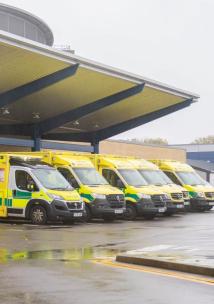Accident and Emergency Services at Queen's Hospital (2022)
At the end of September 2022, Healthwatch Havering carried out an Enter and View visit to the Accident and Emergency (A&E) Services at Queen's Hospital, Romford.

Although the main Emergency Department is provided by the hospital trust, Barking, Havering and Redbridge University Hospitals Trust (BHRUT), A&E services also include a Streaming and Urgent Treatment centre (provided by PELC - the Partnership of East London Co-operatives) and the Ambulance Receiving Centre (provided by the London Ambulance Service -LAS). Healthwatch visited all three centres.
The full report of the visit is now available - see below...
The physical environment of Accident & Emergency Services at Queen’s Hospital has changed – mainly positively – beyond recognition since before the Covid pandemic. Despite the air of temporary arrangements that the Streaming area presents in the main Atrium of Queen’s Hospital, it is a great improvement on what went before; and the ground-breaking Ambulance Receiving Centre means that patients arriving by ambulance for whom immediate treatment is not required, can be looked after in a better way than simply waiting in the vehicle until they can be seen.
It is obvious that all these arrangements are not permanent and that pressure on accommodation within the hospital means that these centres and services must inevitably compete with others for access to the spaces that are available. But equally, it is to be hoped that the improvements that have been made will be retained, if not built upon, in the more permanent arrangements that will follow once the Covid pandemic is fully over.
From a patient’s perspective, the use of the Atrium is welcome – it is airy and spacious in stark contrast to the old A&E reception area which was cramped and very often over-crowded.
The key findings and conclusions of the visit are:
Streaming, Urgent Treatment Centre and Out of Hours GP services
- Deploy hospital volunteers to provide general support to those waiting to be seen and to assist people referred to other parts of the hospital to find their way
- Provide some form of loud-speaker or monitor with names on to call patients
- It would also be helpful for more wheelchairs to be available for those patients awaiting Streaming or to be seen in the UTC or by the OGP who are of limited mobility because of their illness or injury
- Provide additional Streaming points when demand is excessive, to avoid patients having to remain standing for prolonged periods
- A clinician should be available at times of high demand to look out for people in the queue awaiting Streaming who might require priority attention, whether due to the nature of their current illness or injury, or to their age or to a pre-existing condition such as frailty or disability (physical or learning)
Emergency Department
- The lack of beds makes it challenging to give patients the care and experience they deserve and, from our observations during the visit, is the single biggest cause of long waits in the department
- Discharge from hospital continues to cause delay in getting patients from the ED to a mainstream ward as difficulties in transferring patients to settings where social care can be provided mean that patients may remain in hospital for longer than is clinical necessary
- If patients could be discharged at weekends the rush for discharges on a Monday morning could be avoided
As noted in the body of the report, the population served by the hospital has grown greatly over the period since its opening, but its physical capacity has not. Whilst measures to increase the capacity of the hospital are outside the scope of this report, it is to be hoped that NHSNEL and BHRUT will seize any funding opportunity that arises to ensure that the capacity of the hospital can be increased.
Ambulance Receiving Centre
Although the ARC is said to be temporary, there is no doubt that it is a considerable improvement on the arrangements that applied before its introduction. Whilst ideally patients should be taken straight from ambulance to the ED, for the foreseeable future some sort of holding arrangement will be needed and the ARC is important in that.
Closer liaison between the LAS staff in the ARC and BHRUT staff in the ED is welcome and to be encouraged.
Overall issues
The report reflects the visits that we undertook at the three centres that comprise A&E services at Queen’s Hospital. However, these three centres, particularly as winter planning becomes an essential part of the overall care for patients, are highly dependent on a range of social care provisions.
These social care provisions are also a vital component of discharge and home care arrangements for patients, carers and their families. As a follow-up to this report, and to ensure that the complete picture is understood, we intend to work with BHRUT, social care and voluntary organisations to provide a comprehensive report on discharge arrangements.
Our report is a “snapshot” of the position at the end of September 2022. Some innovations were then due but had yet to be implemented, and others may well have emerged since then. The report therefore does not necessarily reflect the way in which any of the centres is now operating.

